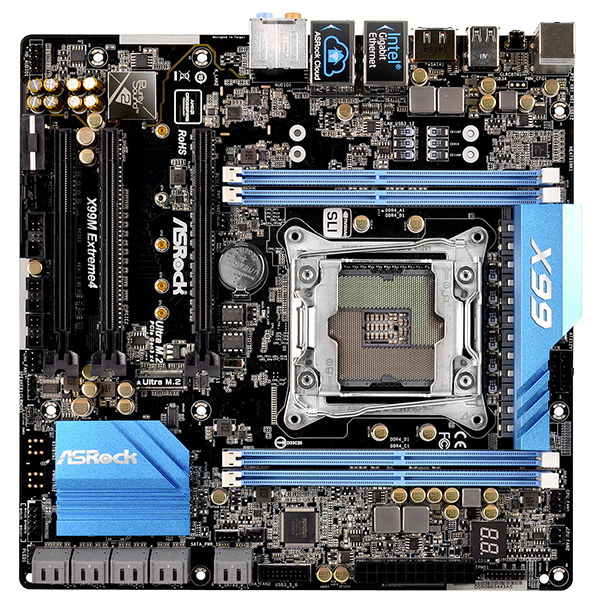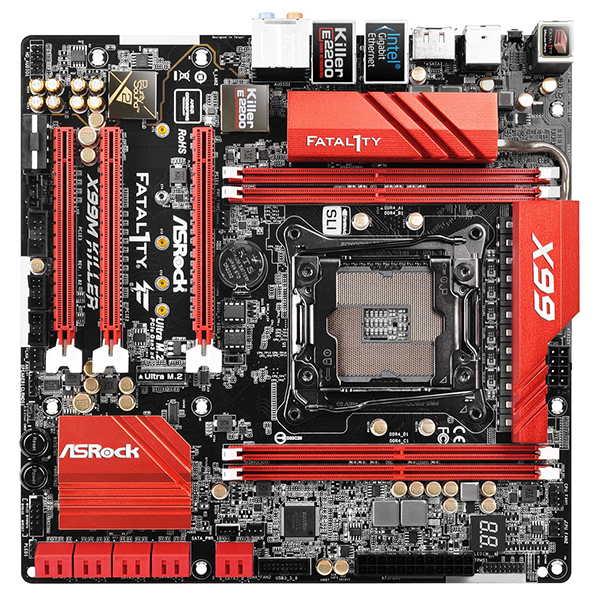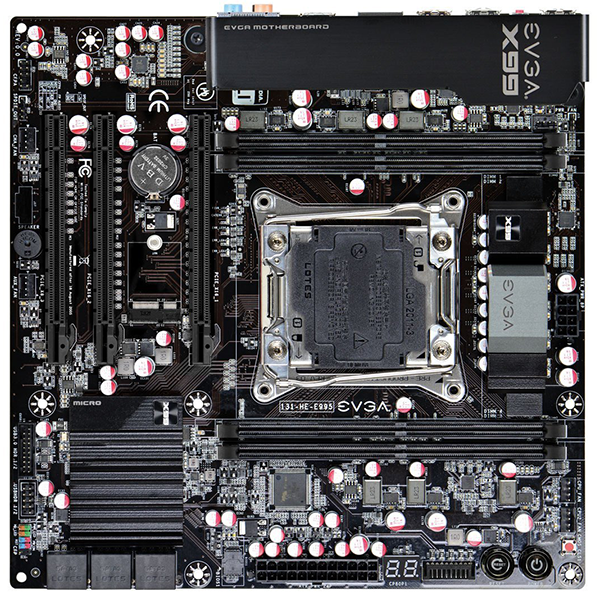Early Verdict
Slightly pricier than ASRock's X99M Extreme4, the Fatal1ty X99M Killer appeals to a smaller market of network and game streaming enthusiasts.
Pros
- +
Dual Gigabit Ethernet, Single Killer Networking Controller, Ultra M.2 Interface
Cons
- -
No Additional USB 3.0 Ports, Third x16 Slot Is Wired PCIe 2.0 x4, Higher Price Than Extreme4
Why you can trust Tom's Hardware
Motherboards In Small Packages
The old idiom “good things come in small packages” is particularly applicable to babies and jewelry. But small is a relative term. For instance, mini-ITX gets lots of attention. But it doesn't have the flexibility to suit the needs of typical high-end gamers. Worse, mini-ITX steals the spotlight from what I consider to be a truly useful form factor, microATX.
Lop the last three slots off of a full ATX motherboard and you've just defined the microATX standard. That means microATX still has enough room around the CPU interface to include a big voltage regulator or support four memory channels. Builders still get up to four slots, which is enough for most, and two-way CrossFire or SLI, which also covers the majority of enthusiasts. In fact, microATX’s only performance-oriented restriction is that, with less slot space to waste, manufacturers tend not to blank out the top slot space in favor of oversized on-board devices.
Many builders realized microATX’s potential for semi-portable gaming machines right before they forgot about them in favor of mini-ITX. A few stood by the design, though. A handful of companies kept the candle lit with power user-class motherboards until recently, and now other companies are stepping in to fill the niche.
We recently gave EVGA’s X99 Micro our seal of approval for standing up to its full ATX rivals in every measurable metric. Now it’s ASRock’s turn. A comparison of its X99M Extreme4 and Fatal1ty X99M Killer motherboards to the X99 Micro may be enlightening, but a comparison between the two ASRock boards is even more entertaining.
| LGA 2011-v3 Micro ATX Motherboard Features | |||
|---|---|---|---|
| Row 0 - Cell 0 | ASRock X99M Extreme4 | ASRock Fatal1ty X99M Killer | EVGA X99 Micro (131-HE-E995-KR) |
| PCB Revision | 1.02 | 1.02 | 1.0 |
| Chipset | Intel X99 | Intel X99 | Intel X99 |
| Voltage Regulator | 12 Phases | 12 Phases | Six Phases |
| 100.0 MHz BCLK | 99.94 (-0.06%) | 99.94 (-0.06%) | 100.19 (+0.19%) |
| I/O Panel Connectors | |||
| P/S 2 | 1 | 1 | 1 |
| USB 3.0 | 4 | 4 | 6 |
| USB 2.0 | 4 | 4 | 4 |
| Network | 2 | 2 | 1 |
| eSATA | 1 | 1 | None |
| CLR_CMOS Button | 1 | 1 | 1 |
| Digital Audio Out | Optical | Optical | Optical |
| Digital Audio In | None | None | None |
| Analog Audio | 5 | 5 | 5 |
| Other Devices | None | None | None |
| Internal Interfaces | |||
| PCIe 3.0 x16 (5960X, 5930K) | 2 (x16/x16) SLI, CrossFire | 2 (x16/x16) SLI, CrossFire | 3 (x16/x16/x8) SLI x3, CrossFire x3 |
| PCIe 3.0 x16 (Core i7-5820K) | 3 (x16/x8/) SLI, CrossFire | 3 (x16/x8/) SLI, CrossFire | 3 (x16/x8/x4) SLI x2, CrossFire x3 |
| PCIe 2.0 x16 | 1 (x4) | 1 (x4) | None |
| PCIe 2.0 x1 | None | None | None |
| USB 3.0 | 1 (2-ports) | 1 (2-ports) | 1 (2-ports) |
| USB 2.0 | 2 (4-ports) | 2 (4-ports) | 1 (2-ports) |
| SATA 6Gb/s | 10 | 10 | 6 |
| SATA Express | None | None | None |
| 4-Pin Fan | 2 | 2 | 5 |
| 3-Pin Fan | 3 | 3 | None |
| FP-Audio | 1 | 1 | 1 |
| S/PDIF I/O | None | None | Output Only |
| Internal Buttons | Power, Reset | Power, Reset | Power, Reset, CLR_CMOS |
| Internal Switch | Dual BIOS IC Selector | Dual BIOS IC Selector | None |
| Diagnostics Panel | Numeric | Numeric | Numeric |
| Other Connectors | TB (Card) Header | TB (Card) Header | EVGA Probe-IT, M.2 Wi-Fi |
| Mass Storage Controllers | |||
| Chipset SATA | 10x SATA 6Gb/s (Includes M.2, eSATA) | 10x SATA 6Gb/s (Includes M.2, eSATA) | 6x SATA 6Gb/s (Includes M.2, SATA-E) |
| Chipset RAID Modes | 0, 1, 5, 10 | 0, 1, 5, 10 | 0, 1, 5, 10 |
| Add-In SATA | None | None | None |
| USB 3.0 | None | None | VL805 PCIe ASM1042 PCIe |
| Networking | |||
| Primary LAN | WGI217V PHY | WGI217V PHY | WGI217V PHY |
| Secondary LAN | AR8171 PCIe | Killer E2200 PCIe | None |
| Wi-Fi | None | None | None |
| Bluetooth | None | None | None |
| Audio | |||
| HD Audio Codec | ALC1150 | ALC1150 | ALC1150 |
| DDL/DTS Connect | DTS Connect | DTS Connect | None |
| Warranty | Three Years | Three Years | Three Years |
ASRock uses the same PCB for both boards, just like Asus and Gigabyte did when they were part of this group. But unlike those competitors, ASRock doesn’t leave any component space unfilled on the less-expensive version, instead switching to a cheaper Ethernet controller from the same brand. Both boards have dual-networking to stand against EVGA’s extra USB 3.0 in value calculations, and the Killer also adds goodies to the box to justify the price hike over its Extreme4 sibling.
Get Tom's Hardware's best news and in-depth reviews, straight to your inbox.
Current page: Motherboards In Small Packages
Next Page ASRock X99M Series Motherboard Overview-
Crashman Reply14730663 said:Just a quick error,
Chipset for all X99 boards is listed as Z97
Fixed, thanks. In case you're wondering, that type of error occurs from continuously recycling tables. -
HideOut To bad the killer model seems to suffer a high markup at amazon according to the green link.Reply -
Lutfij Nice work Thomas! Guess you were sitting on this board in your lab for some time now huh ? :D :)Reply
Anyways, good writeup and keep em coming. Now to find someone crazy enough to shell out on a X99 platform inside an N200 ... hmmm. -
Crashman Reply14733470 said:Nice work Thomas! Guess you were sitting on this board in your lab for some time now huh ? :D :)
Anyways, good writeup and keep em coming. Now to find someone crazy enough to shell out on a X99 platform inside an N200 ... hmmm.
It takes a couple weeks to get stuff published, unless there's an NDA and everyone puts everything else to the side. These would be among the stuff put to the side though :(
At least you knew it was coming :) -
Mac266 Reply14730952 said:
Fixed, thanks. In case you're wondering, that type of error occurs from continuously recycling tables.
Onya Crash. Nice review as well. -
m32 The ASRock Fatal1ty X99M Killer LGA 2011-v3 is selling for $250 ($230 AMIR) on Newegg. Amazon currently isn't selling it on Amazon, and 3rd parties are known to over mark products.Reply -
RedJaron Tom, what would it take to get ASRock to start putting more 4-pin fan headers on their boards? I love their products, been using a Z68 Ex4 Gen3 for three years and just built a friend's machine on an H97M Pro4. But I love quiet PCs. Having PWM signalling for all the chassis fans, and not just the CPU coolers, means it runs as quiet as possible during web surfing and other downtime.Reply



